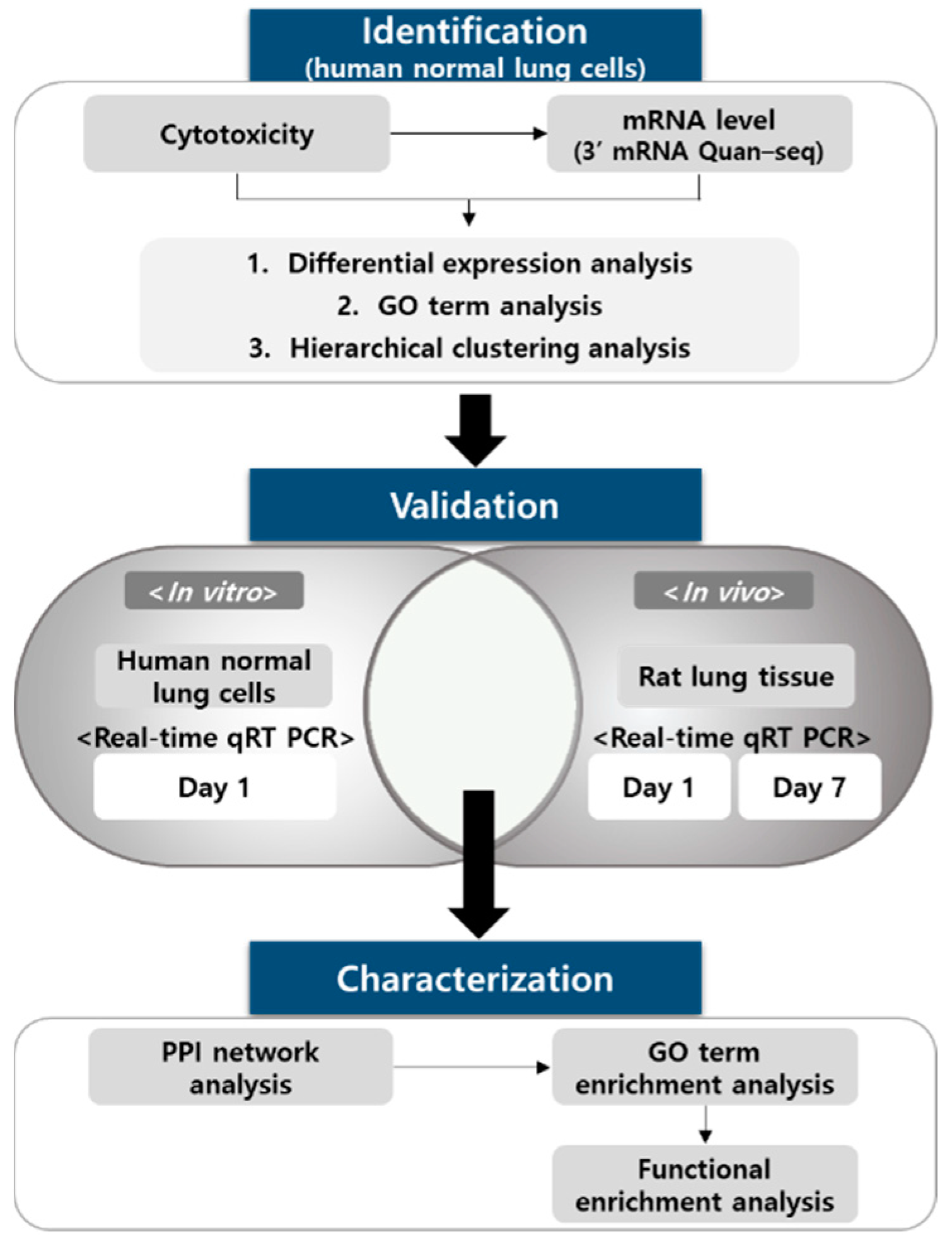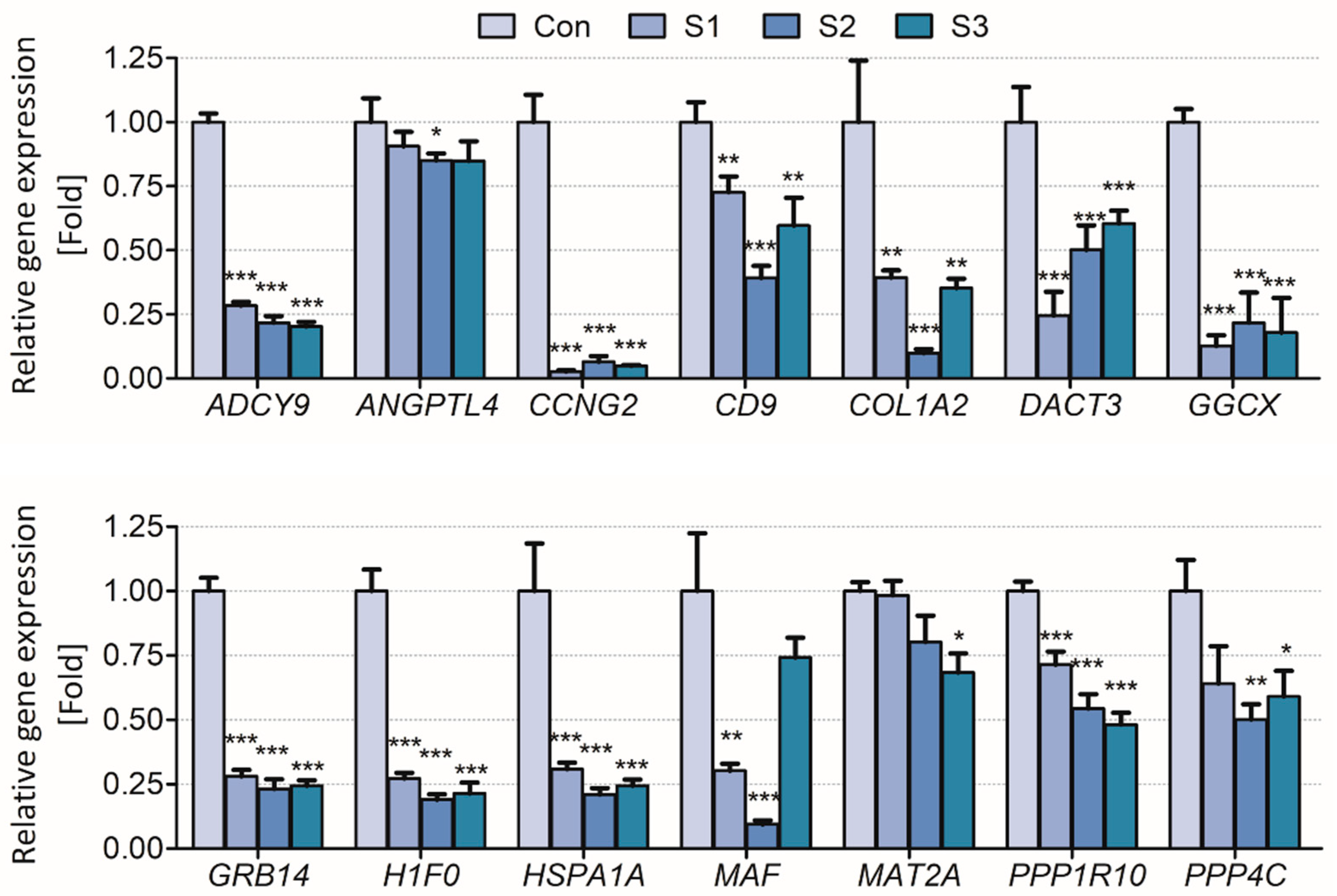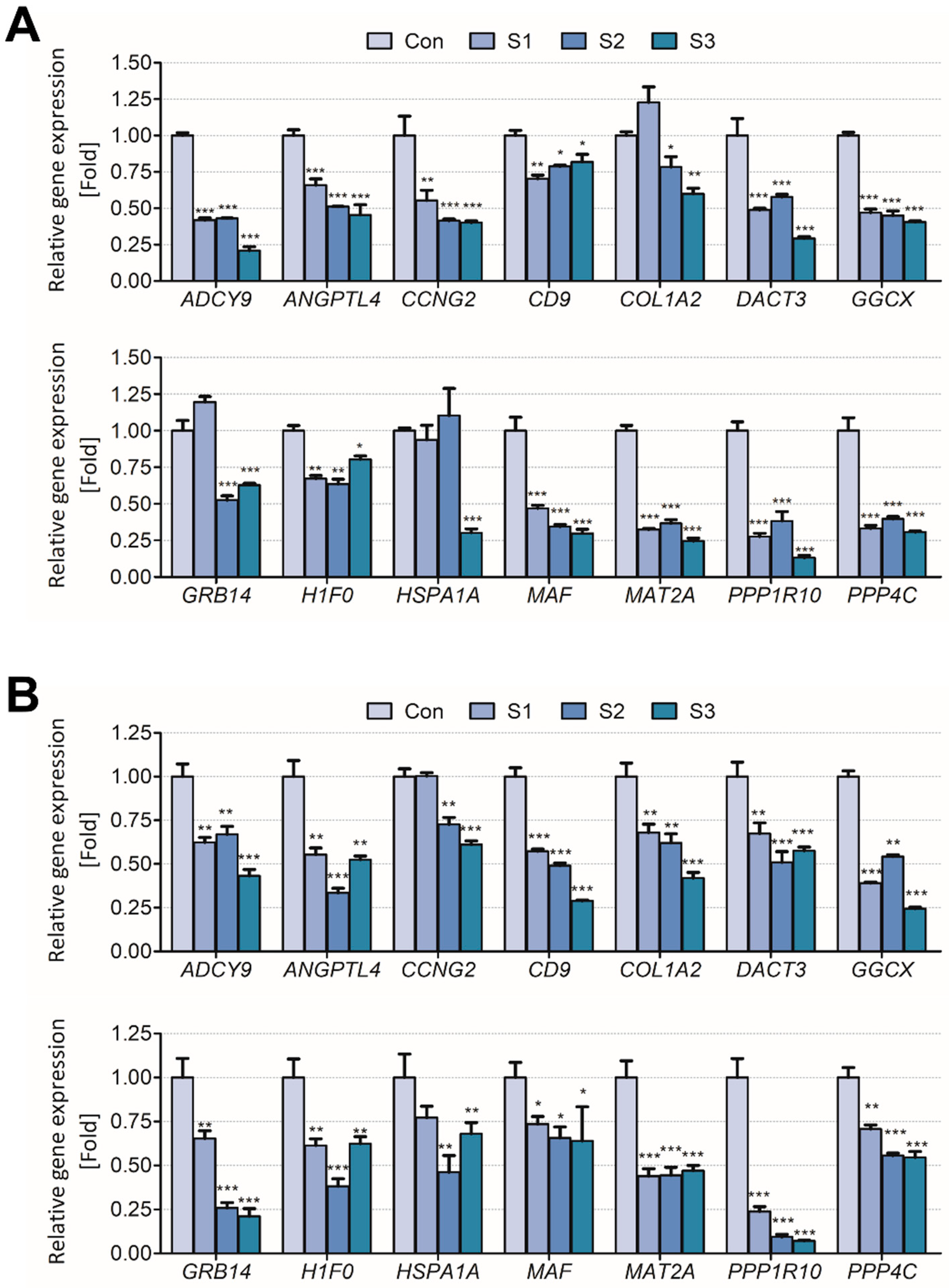Identification and Characterization of mRNA Biomarkers for Sodium Cyanide Exposure
Abstract
:1. Introduction
2. Materials and Methods
2.1. Test Animals
2.2. Cell Culture and Treatments
2.3. Cell-Viability Analysis
2.4. mRNA Extraction
2.5. mRNA Quantification Sequencing (Quan-Seq)
2.6. Gene Ontology (GO) and Pathway Analysis
2.7. Protein–Protein Interaction (PPI) Analysis
2.8. Real-Time Quantitative Reverse Transcription-Polymerase Chain Reaction (Real-Time qRT-PCR)
2.9. Statistical Analysis
3. Results
3.1. Identification of Biomarkers Associated with Sodium Cyanide Exposure
3.2. Validation of the Candidate Biomarkers of Sodium Cyanide Exposure
3.3. Characterization of the Candidate Biomarkers via PPI Network and Functional Enrichment Analyses
4. Discussion
Author Contributions
Funding
Institutional Review Board Statement
Informed Consent Statement
Data Availability Statement
Conflicts of Interest
References
- Rather, I.A.; Koh, W.Y.; Paek, W.K.; Lim, J. The Sources of Chemical Contaminants in Food and Their Health Implications. Front. Pharmacol. 2017, 8, 830. [Google Scholar] [CrossRef] [PubMed] [Green Version]
- Pratt, I.S. Global harmonisation of classification and labelling of hazardous chemicals. Toxicol. Lett. 2002, 128, 5–15. [Google Scholar] [CrossRef]
- Zoller, O.; Rhyn, P.; Zarn, J.A.; Dudler, V. Urine glyphosate level as a quantitative biomarker of oral exposure. Int. J. Hyg. Environ. Health 2020, 228, 113526. [Google Scholar] [CrossRef]
- Pleil, J.D.; Sobus, J.R. Estimating central tendency from a single spot measure: A closed-form solution for lognormally distributed biomarker data for risk assessment at the individual level. J. Toxicol. Environ. Health Part A 2016, 79, 837–847. [Google Scholar] [CrossRef] [PubMed]
- Munoz, B.; Albores, A. The role of molecular biology in the biomonitoring of human exposure to chemicals. Int. J. Mol. Sci. 2010, 11, 4511–4525. [Google Scholar] [CrossRef]
- Jeddi, M.Z.; Hopf, N.B.; Viegas, S.; Price, A.B.; Paini, A.; van Thriel, C.; Benfenati, E.; Ndaw, S.; Bessems, J.; Behnisch, P.A.; et al. Towards a systematic use of effect biomarkers in population and occupational biomonitoring. Environ. Int. 2021, 146, 106257. [Google Scholar] [CrossRef] [PubMed]
- Ryan, P.B.; Burke, T.A.; Hubal, E.A.C.; Cura, J.J.; McKone, T.E. Using biomarkers to inform cumulative risk assessment. Environ. Health Perspect. 2007, 115, 833–840. [Google Scholar] [CrossRef]
- Brucker, N.; do Nascimento, S.N.; Bernardini, L.; Charao, M.F.; Garcia, S.C. Biomarkers of exposure, effect, and susceptibility in occupational exposure to traffic-related air pollution: A review. J. Appl. Toxicol. JAT 2020, 40, 722–736. [Google Scholar] [CrossRef] [PubMed]
- Kiehntopf, M.; Siegmund, R.; Deufel, T. Use of SELDI-TOF mass spectrometry for identification of new biomarkers: Potential and limitations. Clin. Chem. Lab. Med. 2007, 45, 1435–1449. [Google Scholar] [CrossRef]
- Rudel, R.A.; Ackerman, J.M.; Attfield, K.R.; Brody, J.G. New Exposure Biomarkers as Tools for Breast Cancer Epidemiology, Biomonitoring, and Prevention: A Systematic Approach Based on Animal Evidence. Environ. Health Perspect. 2014, 122, 881–895. [Google Scholar] [CrossRef] [PubMed] [Green Version]
- Davis, K.D.; Aghaeepour, N.; Ahn, A.H.; Angst, M.S.; Borsook, D.; Brenton, A.; Burczynski, M.E.; Crean, C.; Edwards, R.; Gaudilliere, B.; et al. Discovery and validation of biomarkers to aid the development of safe and effective pain therapeutics: Challenges and opportunities. Nat. Rev. Neurol. 2020, 16, 381–400. [Google Scholar] [CrossRef] [PubMed]
- Silins, I.; Hogberg, J. Combined toxic exposures and human health: Biomarkers of exposure and effect. Int. J. Environ. Res. Public Health 2011, 8, 629–647. [Google Scholar] [CrossRef] [Green Version]
- Paustenbach, D.; Galbraith, D. Biomonitoring and biomarkers: Exposure assessment will never be the same. Environ. Health Perspect. 2006, 114, 1143–1149. [Google Scholar] [CrossRef] [PubMed] [Green Version]
- Waddell, W.J. Commentary on “Toxicity testing in the 21st century: A vision and a strategy”. Hum. Exp. Toxicol. 2010, 29, 31–32. [Google Scholar] [CrossRef] [PubMed]
- Murdock, B.S. Tracking toxins. Biomonitoring outshines the indirect assessment of exposure in determining which pollulants enter the body, and whether they cause disease or disability. EMBO Rep. 2005, 6, 701–705. [Google Scholar] [CrossRef] [PubMed] [Green Version]
- Landrigan, P.J.; Goldman, L.R. Children’s vulnerability to toxic chemicals: A challenge and opportunity to strengthen health and environmental policy. Health Aff. 2011, 30, 842–850. [Google Scholar] [CrossRef] [Green Version]
- Kim, D.; Chen, Z.; Zhou, L.F.; Huang, S.X. Air pollutants and early origins of respiratory diseases. Chronic Dis. Transl. Med. 2018, 4, 75–94. [Google Scholar] [CrossRef] [PubMed]
- National Research Council. Pesticides in the Diets of Infants and Children; National Academies Press: Washington, DC, USA, 1993. [Google Scholar]
- Saikia, D.; Mahanta, B. Cardiovascular and respiratory physiology in children. Indian J. Anaesth. 2019, 63, 690–697. [Google Scholar] [CrossRef] [PubMed]
- Hauptman, M.; Woolf, A.D. Childhood Ingestions of Environmental Toxins: What Are the Risks? Pediatric Ann. 2017, 46, e466–e471. [Google Scholar] [CrossRef] [PubMed]
- Atterberry, T.T.; Burnett, W.T.; Chambers, J.E. Age-related differences in parathion and chlorpyrifos toxicity in male rats: Target and nontarget esterase sensitivity and cytochrome P450-mediated metabolism. Toxicol. Appl. Pharmacol. 1997, 147, 411–418. [Google Scholar] [CrossRef] [PubMed]
- Dietert, R.R.; Lee, J.E.; Bunn, T.L. Developmental immunotoxicology: Emerging issues. Hum. Exp. Toxicol. 2002, 21, 479–485. [Google Scholar] [CrossRef]
- David, M.; Sangeetha, J.; Harish, E.R. Sodium cyanide induced alteration in the whole animal oxygen consumption and behavioural pattern of freshwater fish Labeo rohita. J. Environ. Biol. 2015, 36, 405–408. [Google Scholar]
- Morningstar, J.; Lee, J.; Hendry-Hofer, T.; Witeof, A.; Lyle, L.T.; Knipp, G.; MacRae, C.A.; Boss, G.R.; Peterson, R.T.; Davisson, V.J.; et al. Intramuscular administration of hexachloroplatinate reverses cyanide-induced metabolic derangements and counteracts severe cyanide poisoning. FASEB Bioadv. 2019, 1, 81–92. [Google Scholar] [CrossRef] [PubMed]
- Vinnakota, C.V.; Peetha, N.S.; Perrizo, M.G.; Ferris, D.G.; Oda, R.P.; Rockwood, G.A.; Logue, B.A. Comparison of cyanide exposure markers in the biofluids of smokers and non-smokers. Biomark. Biochem. Indic. Expo. Response Susceptibility Chem. 2012, 17, 625–633. [Google Scholar] [CrossRef]
- Chen, W.; Roslund, K.; Fogarty, C.L.; Pussinen, P.J.; Halonen, L.; Groop, P.H.; Metsala, M.; Lehto, M. Detection of hydrogen cyanide from oral anaerobes by cavity ring down spectroscopy. Sci. Rep. 2016, 6, 22577. [Google Scholar] [CrossRef]
- Arun, P.; Moffett, J.R.; Ives, J.A.; Todorov, T.I.; Centeno, J.A.; Namboodiri, M.A.A.; Jonas, W.B. Rapid sodium cyanide depletion in cell culture media: Outgassing of hydrogen cyanide at physiological pH. Anal. Biochem. 2005, 339, 282–289. [Google Scholar] [CrossRef] [PubMed]
- Bakshi, K.S.; Krewski, D. Acute exposure guideline levels for selected airborne chemicals—Volume 1—Introduction to the special issue. Inhal. Toxicol. 2001, 13, 102–105. [Google Scholar]
- Narkowicz, S.; Polkowska, Z.; Marc, M.; Simeonov, V.; Namiesnik, J. Determination of thiocyanate (biomarkers of ETS) and other inorganic ions in human nasal discharge samples using ion chromatography. Ecotoxicol. Environ. Saf. 2013, 96, 131–138. [Google Scholar] [CrossRef] [PubMed]
- Jaszczak, E.; Polkowska, Z.; Narkowicz, S.; Namiesnik, J. Cyanides in the environment-analysis-problems and challenges. Environ. Sci. Pollut. Res. Int. 2017, 24, 15929–15948. [Google Scholar] [CrossRef] [Green Version]
- Alissa, E.M.; Ferns, G.A. Heavy metal poisoning and cardiovascular disease. J. Toxicol. 2011, 2011, 870125. [Google Scholar] [CrossRef]
- Scheepers, P.T.J. The use of biomarkers for improved retrospective exposure assessment in epidemiological studies: Summary of an ECETOC workshop. Biomark. Biochem. Indic. Expo. Response Susceptibility Chem. 2008, 13, 734–748. [Google Scholar] [CrossRef] [PubMed]
- Quezada, H.; Guzman-Ortiz, A.L.; Diaz-Sanchez, H.; Valle-Rios, R.; Aguirre-Hernandez, J. Omics-based biomarkers: Current status and potential use in the clinic. Bol. Méd. Hosp. Infant. Méx. (Engl. Ed.) 2017, 74, 219–226. [Google Scholar] [CrossRef]
- Sousa, A.B.; Manzano, H.; Soto-Blanco, B.; Gorniak, S.L. Toxicokinetics of cyanide in rats, pigs and goats after oral dosing with potassium cyanide. Arch. Toxicol. 2003, 77, 330–334. [Google Scholar] [CrossRef] [PubMed]
- Logue, B.A.; Hinkens, D.M.; Baskin, S.I.; Rockwood, G.A. The Analysis of Cyanide and its Breakdown Products in Biological Samples. Crit. Rev. Anal. Chem. 2010, 40, 122–147. [Google Scholar] [CrossRef] [Green Version]
- Bhandari, R.K.; Oda, R.P.; Petrikovics, I.; Thompson, D.E.; Brenner, M.; Mahon, S.B.; Bebarta, V.S.; Rockwood, G.A.; Logue, B.A. Cyanide toxicokinetics: The behavior of cyanide, thiocyanate and 2-amino-2-thiazoline-4-carboxylic acid in multiple animal models. J. Anal. Toxicol. 2014, 38, 218–225. [Google Scholar] [CrossRef] [Green Version]
- Erdogan, M.F. Thiocyanate overload and thyroid disease. BioFactors 2003, 19, 107–111. [Google Scholar] [CrossRef] [PubMed]
- Cipollone, R.; Ascenzi, P.; Frangipani, E.; Visca, P. Cyanide detoxification by recombinant bacterial rhodanese. Chemosphere 2006, 63, 942–949. [Google Scholar] [CrossRef]
- Yu, C.S.; Lin, C.H.; Lin, Y.J.; Lin, S.Y.; Wang, S.T.; Wu, J.L.; Tsai, M.H.; Chang, S.S. Clustering Heatmap for Visualizing and Exploring Complex and High-dimensional Data Related to Chronic Kidney Disease. J. Clin. Med. 2020, 9, 403. [Google Scholar] [CrossRef] [Green Version]
- Dean, J.L.; Zhao, Q.J.; Lambert, J.C.; Hawkins, B.S.; Thomas, R.S.; Wesselkamper, S.C. Editor’s Highlight: Application of Gene Set Enrichment Analysis for Identification of Chemically Induced, Biologically Relevant Transcriptomic Networks and Potential Utilization in Human Health Risk Assessment. Toxicol. Sci. 2017, 157, 85–99. [Google Scholar] [CrossRef]
- Stelzl, U.; Worm, U.; Lalowski, M.; Haenig, C.; Brembeck, F.H.; Goehler, H.; Stroedicke, M.; Zenkner, M.; Schoenherr, A.; Koeppen, S.; et al. A human protein-protein interaction network: A resource for annotating the proteome. Cell 2005, 122, 957–968. [Google Scholar] [CrossRef] [PubMed] [Green Version]
- Szklarczyk, D.; Gable, A.L.; Nastou, K.C.; Lyon, D.; Kirsch, R.; Pyysalo, S.; Doncheva, N.T.; Legeay, M.; Fang, T.; Bork, P.; et al. Correction to ‘The STRING database in 2021: Customizable protein-protein networks, and functional characterization of user-uploaded gene/measurement sets’. Nucleic Acids Res. 2021, 49, 10800. [Google Scholar] [CrossRef] [PubMed]
- Subramanian, A.; Tamayo, P.; Mootha, V.K.; Mukherjee, S.; Ebert, B.L.; Gillette, M.A.; Paulovich, A.; Pomeroy, S.L.; Golub, T.R.; Lander, E.S.; et al. Gene set enrichment analysis: A knowledge-based approach for interpreting genome-wide expression profiles. Proc. Natl. Acad. Sci. USA 2005, 102, 15545–15550. [Google Scholar] [CrossRef] [PubMed] [Green Version]






| Gene Symbol | Annotation | |||
|---|---|---|---|---|
| Description | Chromosome | Strand | Transcript_ID | |
| ADCY5 | Adenylate cyclase 5 | Chr3 | – | NM_183357 |
| ANGPTL4 | Angiopoietin like 4 | Chr19 | + | NR_104213 |
| CCNG2 | Cyclin G2 | Chr4 | + | NM_004354 |
| CD9 | CD9 molecule | Chr12 | + | NM_001769 |
| COL1A2 | Collagen type I alpha 2 | Chr7 | + | NM_000089 |
| DACT3 | Dishevelled-binding antagonist of beta-catenin 3 | Chr19 | – | NM_001301046 |
| GGCX | Gamma-glutamyl carboxylase | Chr2 | – | NM_001142269 |
| GRB14 | Growth factor receptor bound protein 14 | Chr2 | – | NM_001303422 |
| H1F0 | H1 histone family member 0 | Chr22 | + | NM_005318 |
| HSPA1A | Heat shock protein family A (Hsp70) member 1A | Chr6 | + | NM_005345_3 |
| MAF | v-maf avian musculoaponeurotic fibrosarcoma oncogene homolog | Chr16 | – | NM_005360 |
| MAT2A | Methionine adenosyltransferase 2A | Chr2 | + | NM_005911 |
| PPP1R10 | Protein phosphatase 1 regulatory subunit 10 | Chr6 | – | NR_072994 |
| PPP4C | Protein phosphatase 4 catalytic subunit | Chr16 | + | NM_001303506 |
Publisher’s Note: MDPI stays neutral with regard to jurisdictional claims in published maps and institutional affiliations. |
© 2021 by the authors. Licensee MDPI, Basel, Switzerland. This article is an open access article distributed under the terms and conditions of the Creative Commons Attribution (CC BY) license (https://creativecommons.org/licenses/by/4.0/).
Share and Cite
Kim, M.; Jee, S.-C.; Kim, S.; Hwang, K.-H.; Sung, J.-S. Identification and Characterization of mRNA Biomarkers for Sodium Cyanide Exposure. Toxics 2021, 9, 288. https://doi.org/10.3390/toxics9110288
Kim M, Jee S-C, Kim S, Hwang K-H, Sung J-S. Identification and Characterization of mRNA Biomarkers for Sodium Cyanide Exposure. Toxics. 2021; 9(11):288. https://doi.org/10.3390/toxics9110288
Chicago/Turabian StyleKim, Min, Seung-Cheol Jee, Soee Kim, Kyung-Hwa Hwang, and Jung-Suk Sung. 2021. "Identification and Characterization of mRNA Biomarkers for Sodium Cyanide Exposure" Toxics 9, no. 11: 288. https://doi.org/10.3390/toxics9110288
APA StyleKim, M., Jee, S.-C., Kim, S., Hwang, K.-H., & Sung, J.-S. (2021). Identification and Characterization of mRNA Biomarkers for Sodium Cyanide Exposure. Toxics, 9(11), 288. https://doi.org/10.3390/toxics9110288






